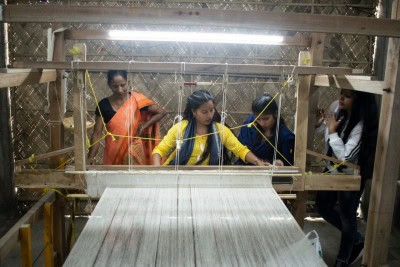
 By Siddhi Jain
By Siddhi Jain
New Dehi, Aug 10 (IANSlife) As a young girl, Assam’s artisan entrepreneur Nabanita Kalita saw her mother, grandmother and aunts spend hours on the handloom weaving beautiful Mekhela Chador and Ghamosas and other textiles for the family. Years later, taking an entrepreneurial turn, Kalita’s passion and knowledge of traditional handloom fuels her textile venture – one among many in the region’s craft ecosystem.
“In Assam, weaving is part of our tradition which gets passed on from the mothers to their daughters. The rhythmic movement of a loom with my mother’s soft humming while weaving, was a sight that I fondly remember. Today, my mother overlooks when I weave products on the loom. It gives me immense pride that I have been passed on this skill,” Kalita, who is based in Assam’s handloom cluster Kamrup, told IANSlife.
Not many, however, are like Kalita. A growing reluctance among artisanal communities to carry forward a generational craft, has thinned out existing practitioners for handloom and handicrafts. For her, what helped what Antaran, a key intervention of the Tata Trusts’ craft-based livelihood programme.
It is a direct implementation five-year programme of Tata Trusts that was initiated to bring seminal changes in craft development and aims at rejuvenating ailing handloom clusters through an end-to-end programme that helps and educates artisans/weavers. It was initiated in regions that were economically vulnerable, where agriculture is not a viable source of income, instead there is a prevalence of a weaving culture. Community initiatives are currently across four states and six handloom clusters in – Assam (Kamrup and Nalbari), Nagaland (Dimapur), Odisha (Gopalpur and Maniabandha) and Andhra Pradesh (Venkatagiri).
In her association with the educational program of Antaran, Kalita gained insights about design, communication and business, and set up her microenterprise ‘Brahmputra Handloom’.
“The initiative has given the opportunity to women artisans of Assam to use the skills and present the heritage and tradition of our textiles to the world. In October 2019, when I was selected to be a part of the Antaran exhibit at the India Fashion Week in New Delhi, I was thrilled and nervous as it was my first time to the city and being a part of the fashion week. My parents were hesitant earlier for me to venture out, but eventually they understood the importance of the exposure and agreed to send me. I have built confidence in interacting with designers and buyers and explained the nuances of my handwoven products. There is a strong notion in the community now that the artisans backed with the right set of knowledge and skills can make a difference and I strive to take my enterprise forward and showcase the beauty and pride of Assamese textiles.
“Women in our cluster had never imagined that they would be selling their creations to so many customers and buyers outside whom they had not even met, while earlier none of our products had moved out of our own village,” she said, highlighting the need for the right platform.
Strengthening craft ecosystems, building core strength of handloom textiles such as natural fibres, hand-spun yarn and natural dyes, while reviving and reinterpreting the traditional weave designs in these selected clusters for wider markets are key aims of the initiative.
“Antaran initiative aims to rejuvenate six ailing handloom clusters through an end-to-end programme. The overarching objective of this intervention is to transform six pilot weaving clusters by creating entrepreneur-led microenterprises across each element of the value chain.
“The intervention will directly benefit 3,000 people involved in pre-loom, on-loom and post-loom processes, while also impacting the livelihood of thousands of weavers in these regions. This unique initiative also presents designers and market an opportunity for creative collaboration with talented weavers from these hitherto hidden clusters,” Sharda Gautam, Head of Crafts, Tata Trusts, told IANSlife.
Signing off, Kalita highlights how she uses social media to connect her business to the larger world and has a lot to explore even now – from product photography to coordinating with buyers via WhatsApp and understanding digital payment systems from home.
(Siddhi Jain can be contacted at siddhi.j@ians.in)
Disclaimer: This story is auto-generated from IANS service.

